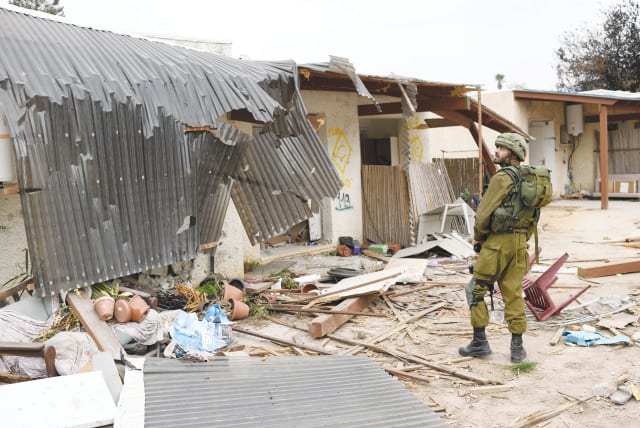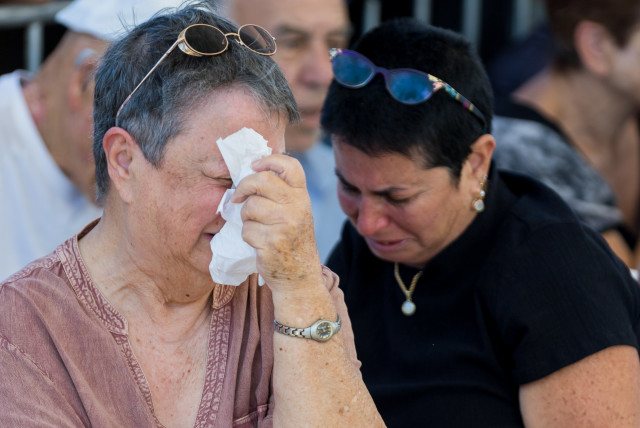The horrors of Kfar Aza fail to be comprehended - opinion

A visit to Kfar Aza left me speechless, nearly ill, and forever changed.
Nothing puts the Israeli-Palestinian conflict into perspective more than visiting the Gaza border. I have gone there on strategic geopolitical tours several times, and I have visited several communities that live under constant rocket fire during Hamas flares and heavy operations. On a quiet day, when you stand on the edge of the Gaza envelope, you can see the Strip in the distance, and depending on where you stand, you can even see Hamas lookout posts that usually parallel the Israeli counterparts.
When you see Gaza from a distance, several things can go through your mind, like: How is it possible that we have such a tragic reality with our neighbors who are literally within walking distance? How can groups of people who live so close to one another not have been able to find a solution to improve their lives? I always wanted to learn and understand what the reality was on the other side of the border for the Palestinians living a few kilometers away.
This past week, a visit to Kfar Aza changed everything for me.
Kfar Aza sits about five kilometers east of the Gaza Strip. It was one of the many Israeli communities devastated by the October 7 Hamas massacre. What was once a beautiful, quaint, and peaceful kibbutz is now desolate, broken, and frozen in time, as it was on that dark Saturday.
It is eerie and quiet as we make our way to the center of where the massacre took place. There are rows of houses that look like different versions of chaos, based on how the Hamas terrorists carried out their crimes. Some of the homes are covered with large bullet holes that start at the doorways and move into the living rooms or safe rooms of the residents. Others are reduced to rubble, while some are completely burned, blackened, and charred from the grenades that the terrorists tossed inside while the families were still in there.
I later found out that the large holes in the wall that I thought were from bullets were actually from the grenade pellets that burst through the walls. Some of the homes were so severely burned that archeologists had to be brought in to sift through the ash. Both inside and outside, the families’ personal belongings are scattered everywhere.
A SHARP stench hits my nose as we walk into some of the homes and see photos and personal items of these families that are now gone. The smell is a mix of rotting blood, the stench of the dead bodies that have been removed, and leftover rotting food. The smell was so overwhelming that I needed to run out of the house, fearing that I was going to vomit.
Mostly, it’s quiet besides the crunching sounds of our shoes walking over the shattered glass and debris covering the entire ground. You can stand there, lost in your thoughts, when an explosion jolts your body into a moment of panic. Those sounds are the IDF carrying out their mission against Hamas in Gaza. While our minds know that those sounds are coming from six kilometers away, our bodies react as those sounds are happening right over our heads.
I walk to a back area where I see about 20 cars completely torched, covered in bullet holes and shattered window glass. In the middle of the ruined cars is a motorcycle from a Hamas terrorist who drove it past the border. Behind the group of cars, you can see Gaza and the breached fence with a massive gap in the middle of the barbed wire. This, I’m told, is the exact area of the fence where the terrorists infiltrated. My first thought is, how on earth did anyone think that a feeble fence like this ever stood a chance against infiltration?
We met some residents from Kfar Aza, including a young girl named Yaheli, who showed us where her friend Ofir Shoshani lived (a home now reduced to char and ashes). She told us that Ofir had called for help, but nobody answered or showed up before she died.
Over 70 terrorists infiltrated the Kfar Aza community and murdered around 60 residents. However, the exact number is not yet confirmed because some of the bodies were burned and tortured to the point where the victims have not yet been identified. There are also 17 confirmed hostages in Gaza from this community. Children were among the victims in Kfar Aza, including some who were found beheaded. Other residents from this community were tortured, and the women were raped.
A MEMBER of Israel’s search and rescue organization, Zaka, came to speak to our group toward the end of our visit. Simcha Greininam, who usually works as a carpenter, closed his business and has been volunteering with Zaka since October 7. Their goal is to find and rescue the bodies, identify the victims, and try to give the families of the dead a body to bury. Greininam begins by telling us some of the things he discovered with his own eyes and describes walking into a home to see a birthday cake on the table, meaning the family was likely supposed to celebrate a special occasion that day.
He describes looking at this family’s fridge and seeing photos of their smiling faces plastered everywhere. He then describes being hit with the smell of their dead bodies in another room. Simcha begins to break down as he describes walking into the room and finding the bodies of the two parents, two children, and grandmother huddled together, hugging each other.
This family spent their last moments latched together to hold each other one last time. Simcha and his team were forced to break the family apart from one another. I don’t understand how Zaka volunteers have the mental and emotional strength to volunteer and do this job. They are genuinely this nation’s unsung heroes.We walk back to the bus, and I realize there is still a whiff of that terrible smell from the homes that seems to engulf the entire Kibbutz. I guess this is what death smells like.
How seeing Kfar Aza forever changed me
I am fortunate enough that I, personally, don’t know anyone who was murdered or kidnapped on October 7, so I believed that I would more or less be okay. Yet when I came back to Tel Aviv that evening, a mere two-hour drive away from Kfar Aza, and tried to explain to others what I saw, I suddenly realized I couldn’t physically form sentences. My brain was unable to process or formulate thoughts. Only days later, what I saw finally hit me, and the pain of those stories felt as if these people were my own family.
I want to forget what I saw, heard, and smelled in Kfar Aza. I can still smell that terrible stench of death and destruction. But I cannot forget because I need to know what Hamas and any force that wants to destroy the Jewish people is capable of – and to let the world know too.
The writer is a social media activist with over 10 years of experience working for Israeli and Jewish causes and cause-based NGOs. She is co-founder and COO of Social Lite Creative, a digital marketing firm specializing in geopolitics.
Jerusalem Post Store
`; document.getElementById("linkPremium").innerHTML = cont; var divWithLink = document.getElementById("premium-link"); if (divWithLink !== null && divWithLink !== 'undefined') { divWithLink.style.border = "solid 1px #cb0f3e"; divWithLink.style.textAlign = "center"; divWithLink.style.marginBottom = "15px"; divWithLink.style.marginTop = "15px"; divWithLink.style.width = "100%"; divWithLink.style.backgroundColor = "#122952"; divWithLink.style.color = "#ffffff"; divWithLink.style.lineHeight = "1.5"; } } (function (v, i) { });

